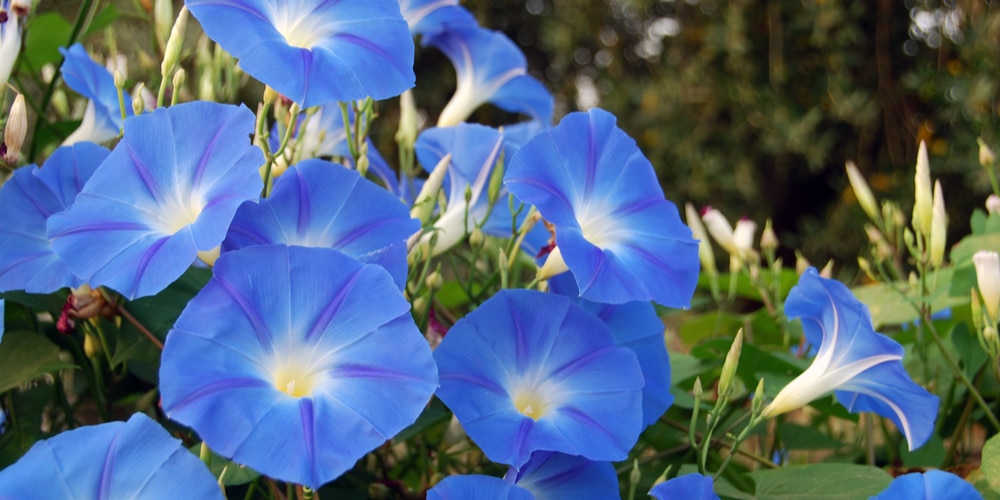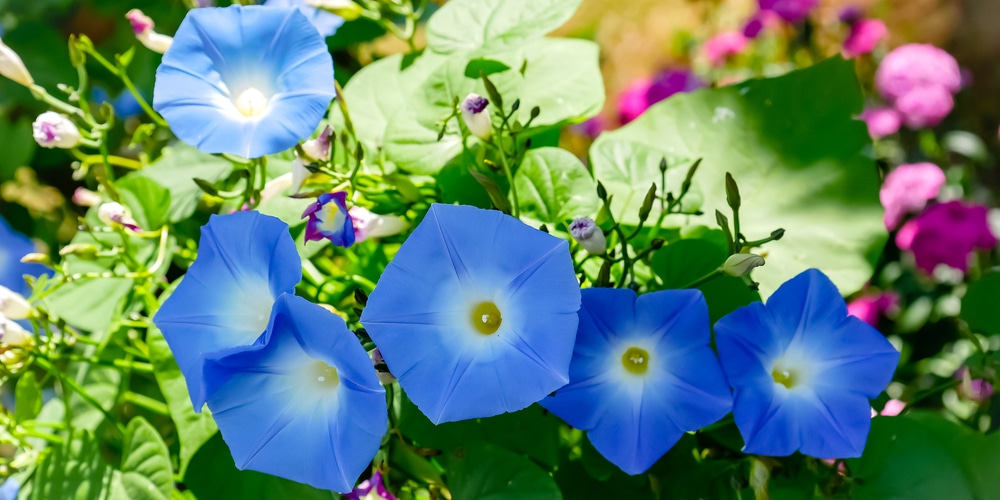Ipomoea tricolor has many names: flying saucer, granny vine, heavenly blue, Mexican morning glory, or just morning glory. It’s a perennial, herbaceous vine that does well in cooler areas than in its tropical origin of Mexico. It’s recognized for its white, blue, and variously colored funnel-shaped flowers and twining nature. Its large brassy flowers open up in the morning, after which they fade and drop by evening. Let’s look at flowers that start with I.
Flowers That Start with i: Ipomoea tricolor

Like all morning glories, Ipomoea tricolor blooms in the spring, but it can stay vibrant all year long. As for its care, it is relatively easy to grow and does well in a sunny location. Also, it needs regular watering and fertilization during the growing season.
Caring For Your Morning Glory
The table below has basic information about morning glory to introduce you to this plant care:
- Common names: Mexican morning glory, granny vibe, morning glory
- Family: Convolvuaceae
- Plant Type: Climbers
- Sunlight Exposure: Full Sun
- Plant Family: lpomoea – Morning Glories
- Season of Interest: Summer (Early, Mid, Late), Fall
- Spreads: 3’ – 6 (90cm – 180cm)
- Height: 8’ – 10 (240cm – 3m)
- Water Needs: Average plant
- Soil Type: Chalk. Loam, Sand
- Maintenance: Low
- Soil pH: Acid. Alkaline, Neutral
- Characteristics: Plant of Merit, Showy
- Soil Drainage: Moist but Well-Drained
- Pests & Diseases: Aphids, leaf miners, mites. Also, leaf spots, blister rots, and rust.
- Leaf Description: Green alternate, simple, heart-shaped, 3-4 inches long leaves.
Light requirement
Ipomoea tricolor likes full sun and thrives best when exposed to lots of light. While it can tolerate partial shade, this sun-worshipping Mexican morning glory does best when treated as a warm-weather annual. It can grow up to 15 feet tall and spread up to 10 feet wide if not pruned back.
Soil
Ipomoea tricolor likes well-drained soil. The soil should be loose and loamy with a pH of 6-7. Avoid soils with too much-composted material because they may be too rich for your plant. You should avoid using rock wool, mainly used in gardening today.
Plant spacing
The plant grows best when planted in groups of 3-5 vines. Plant them in a location or container where they can grow up to 15 feet apart.
Pruning
It’s best to prune your morning glory every year in the spring. This will help keep it healthy and prevent it from getting too tall. You can remove one or two vines each year, but you should avoid drawing too many vines at once.
Feeding and Fertilizing
The plant needs little fertilizer during the growing season–avoid over-fertilizing because it could burn its roots. Avoid fertilizing in the fall and winter when the plant is dormant. In fact, fertilizer isn’t necessary when planting moderately-fertile soil.
Propagation
You can plant morning glories from seed, but they are said to take a long time to germinate. You can also buy young plants from a nursery or online. If you want to propagate your morning glories, you can take cuttings of young vines and let them sit in water for a few days before planting them in the soil.
Pests and Diseases
There are no serious pests or diseases that affect Ipomoea tricolor. However, it is susceptible to mealybugs and spider mites. It is easy to control mealybugs with a spray of insecticidal soap and spider mites with water and a mild soap solution.
Morning Glory Problems
Most problems with morning glory are disease-related. If you notice any problem with your plant, treat it with a fungicide and then water well. You can also use a pest control solution to prevent infestation and diseases.
Morning Glory Leaf Spot
Morning Glory Leaf Spot is caused by Phoma macrocarpa. This fungus spreads through spores that insects, people, or animals spread. The disease starts as small, yellow spots on the leaves. The spots become brown or gray as the disease progresses, causing leaf deformity and leaf drop.
Morning Glory Knots
Morning Glory Knots are caused by Phragmidium oryzae. This fungus can cause swelling of plant stems, stunting, and death of the plant. It’s most common during wet weather. The disease starts as tiny knots on the stem that progress to become swollen with watery fluid between them.
Morning Glory Rust
Morning Glory Rust is caused by Puccinia triticina. Wind, insects, or rain are the agents that spread this fungus. The disease starts as small orange-brown spots on the leaves. As the disease progresses, the spots become brown and may darken to black.
Morning Glory Whitefly
Morning Glory Whitefly is caused by Trialeurodes vaporariorum. It’s spread by a pest that feeds on morning glories, making them wilt and eventually die. Morning Glory Whiteflies are most common during wet weather. They can be controlled with a spray of insecticidal soap.
Stem Rot
Stem Rot is caused by Phoma stem rot. This fungus can be spread by insects, birds, or people. The disease starts as small galls on the stem of morning glories. The galls enlarge and may cause the stem to die and fall off.
Related article: Flowers That Start with S
